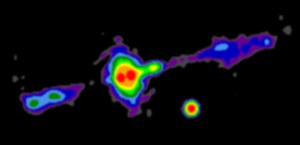Probing the Torus of an Active Galactic Nucleus
 An active galactic nucleus (AGN) corresponds to the process of prodigious energy production by gas in-fall onto a supermassive black hole. In this work, Carilli et al. present the first direct imaging of what may be the thick torus in the AGN of the archetype powerful radio galaxy Cygnus A, using the Jansky Very Large Array at 18–48 GHz, with a resolution down to 45 milli-arcseconds. Such a torus has long been a key component of AGN models, but direct imaging on the relevant physical scales in sources of extreme (quasar-like) luminosities, remains scarce. An elongated structure, perpendicular to the radio jets and centered on the core, is well resolved, with a full length of 0.48 arcsec (528 pc), and a full width of 0.26 arcsec (286 pc). The radio emission spectrum is consistent with optically thin free–free emission. The authors present a toy model of a flaring torus, with a half-opening angle for the poloidal region of 62°. The radio jets are oriented along the poles. The observations require a clumpy gas distribution, with the free–free emission dominated by clumps with densities ≥ 4000 cm−3.
An active galactic nucleus (AGN) corresponds to the process of prodigious energy production by gas in-fall onto a supermassive black hole. In this work, Carilli et al. present the first direct imaging of what may be the thick torus in the AGN of the archetype powerful radio galaxy Cygnus A, using the Jansky Very Large Array at 18–48 GHz, with a resolution down to 45 milli-arcseconds. Such a torus has long been a key component of AGN models, but direct imaging on the relevant physical scales in sources of extreme (quasar-like) luminosities, remains scarce. An elongated structure, perpendicular to the radio jets and centered on the core, is well resolved, with a full length of 0.48 arcsec (528 pc), and a full width of 0.26 arcsec (286 pc). The radio emission spectrum is consistent with optically thin free–free emission. The authors present a toy model of a flaring torus, with a half-opening angle for the poloidal region of 62°. The radio jets are oriented along the poles. The observations require a clumpy gas distribution, with the free–free emission dominated by clumps with densities ≥ 4000 cm−3.
Image: VLA image of the central region of the powerful radio galaxy Cygnus A, showing the doughnut-shaped torus surrounding the black hole and accretion disk (C.L. Carilli et al.)
Publication: C.L. Carilli (National Radio Astronomy Observatory) et al., Imaging the Active Galactic Nucleus Torus in Cygni A, Astrophysical Journal Letters, 874, L32 (5 April 2019).
NRAO Press Release: VLA Makes First Direct Image of Key Feature of Powerful Radio Galaxies




Connect with NRAO